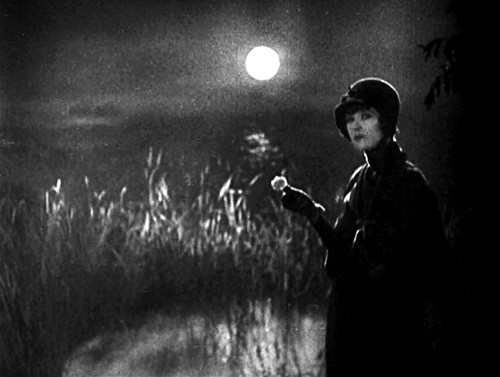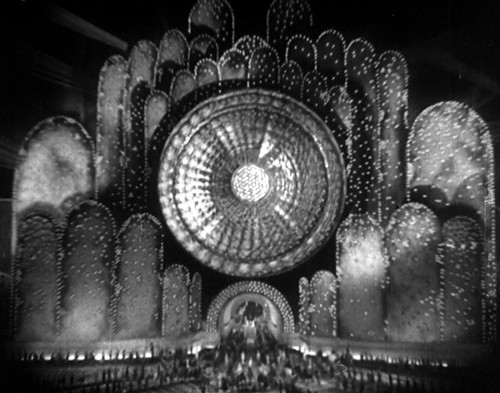
Sunrise: A Song of Two Humans, 1927
Dir: F.W. Murnau
September 16, 2009
After reading a very positive review on this site for Sunrise, I got the opportunity to see it last night on big screen at the Harvard Film Archive for free. The seats are pretty clunky and whatnot, but seeing a great film in a theater is really worth it sometimes, especially when its free. I'm not sure why I've never gone there before. It's really great. Having only seen Nosferatu (1922) before this, I am even more interested in Murnau's other stuff now, considering his obvious influences in romantic and impressionistic art.

The story sets up an adulterous farmer (The Man) (George O'Brien) who contemplates killing his young wife (Janet Gaynor) to head for the city with a scheming woman (Margaret Livingston). The amazing black and white photography (not to mention hair color) immediately sets up the wife as "light" lady (with a child) and the woman from the city as the "dark" lady. It's pretty classic fable stuff, and Muranu works it really well. The affair has ruined the lives of The Man and The Wife, who were once happy and prosperous on their farm. In a visually striking and atmospheric scene, The Dark Lady convinces The Man to drown The Wife in order to move with her to the City. The Man easily convinces The Wife to go for a boat ride across the water, as she longs for time with her husband.




The scene on the boat where The Man can't follow through on the plan plays on his inner torment well, just as he wrestled with his demons right after his secret meeting with the Dark Lady. The Man readies himself to throw The Wife overboard. He looks into her eyes and realizes that he can’t do it, however, and the boat reaches the shore. The Wife flees and The Man follows. The pair winds up in the City and a story of redemption, forgiveness, and romance develops.
There are multiple angles with this relatively simple story. For starters, one might be wondering how The Wife ever took The Man back after this attempted murder. The stark forgiveness seems a bit like naiveté, in a way, but so desperate is The Man to have his Wife back that one can’t help but feel for him somewhat. He has made a horrible, terrifying error in judgment and has been swept up in the tide of adulterous lust. The Dark Lady’s spell on him broken, his clarity begs him to change his ways.
What happens in the city is somewhat divergent in tone to the rest of the film, but part of understanding the total gravity of Sunrise is to understand what filmgoers were expecting and what they would have received upon seeing this in the late 20s. This was Murnau's first Hollywood movie, and there was probably some expectation that certain things would be in it from the studio. It's a credit to Murnau that he makes slice-of-life stuff so engaging and funny, and not to mention relevant to the rest of the feature. Drunk pigs (or animals in general) are always funny, too. It's also a little look into Murnau "queer" sensibility (the barbershop scene), who never really made it a secret that he was gay (causing all sorts of crazy rumors when he died in 1931).

There are multiple angles with this relatively simple story. For starters, one might be wondering how The Wife ever took The Man back after this attempted murder. The stark forgiveness seems a bit like naiveté, in a way, but so desperate is The Man to have his Wife back that one can’t help but feel for him somewhat. He has made a horrible, terrifying error in judgment and has been swept up in the tide of adulterous lust. The Dark Lady’s spell on him broken, his clarity begs him to change his ways.
What happens in the city is somewhat divergent in tone to the rest of the film, but part of understanding the total gravity of Sunrise is to understand what filmgoers were expecting and what they would have received upon seeing this in the late 20s. This was Murnau's first Hollywood movie, and there was probably some expectation that certain things would be in it from the studio. It's a credit to Murnau that he makes slice-of-life stuff so engaging and funny, and not to mention relevant to the rest of the feature. Drunk pigs (or animals in general) are always funny, too. It's also a little look into Murnau "queer" sensibility (the barbershop scene), who never really made it a secret that he was gay (causing all sorts of crazy rumors when he died in 1931).

The prime focal point of Sunrise is the camerawork and direction. As good as the actors are, and they are tremendous, especially Gaynor, Murnau’s direction is the stuff of legends. The framing of the shots, the use of superimposed images and how they were created in the camera and not in the editing room, and Murnau’s gift for using bits of nature as mood props add up to an seriously impressive not to mention artistic film.

Like Nosferatu, this is a film told with images. A clear mark of a maturing artist is that his form improves, and if you can remember Nosferatu well, you know it is heavily titled. Here, the titles are left to the bare minimum and the images give you all the information you need, especially with the way Murnau and the cinematographers dealt with light. It's interesting to note that while the "rules" of cinema were being written by D.W. Griffith during this period, Murnau and the German Expressionist were already breaking them. If there is any silent film to show someone, this is probably it.


Like Nosferatu, this is a film told with images. A clear mark of a maturing artist is that his form improves, and if you can remember Nosferatu well, you know it is heavily titled. Here, the titles are left to the bare minimum and the images give you all the information you need, especially with the way Murnau and the cinematographers dealt with light. It's interesting to note that while the "rules" of cinema were being written by D.W. Griffith during this period, Murnau and the German Expressionist were already breaking them. If there is any silent film to show someone, this is probably it.

No comments:
Post a Comment